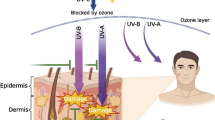Abstract
Reflectance characteristics of the epidermal coverings (hair, feathers) of several white birds and mammals were examined in the visible and ultraviolet regions of the solar spectrum. Non-white phases of the same species, and other non-white animals were examined for comparison. As expected, non-white animals exhibited lower reflectance values than white animals in the visible spectrum. Most species examined demonstrated reduced reflectance in the ultraviolet, reaching minimum values between 290 and 310 nm. In white animals, significant differences were found in the reflectance of UV-A (320–400 nm) and UV-B (280–320 nm) radiation. This accounts for the apparent differences in ultraviolet reflectance among various arctic mammals detected previously with ultraviolet photography. Reflectance patterns in the visible and ultraviolet were not obviously correlated with phylogenetic relationship, nor with the gross structure of hair or feathers.
Similar content being viewed by others
References
ADAMS, D. B. and ADAMS, S. T. (1974): Ophthalmology in the Canadian north. Arctic, 27: 91–94.
BLACK, H. S. and CHAN, J. T. (1977): Experimental ultraviolet light-carcinogenesis. Photochem. Photobiol., 26: 183–199.
COWLES, R. B. (1967): Black pigmentation: adaptation for concealment or heat conservation? Science, 158: 1340–1341.
DANIELS, F. JR. (1964): Man and radiant energy: solar radiation. In: Handbook of Physiology. Section 4: Adaptation to the Environment. D. B. Dill (ed.), American Physiological Society, Washington, D. C., 969–987.
ESVELT, R. P., SCHNOES, H. K., and DELUCA, H. F. (1978): Vitamin D3 from rat skins irradiatedin vitro with ultraviolet light. Arch. Biochem., 188: 282–286.
FOX, H. M. and VEVERS, G. (1960): The Nature of Animal Colours. Sidgwick and Jackson Ltd., London. 246 pp.
Giese, A. C. (1976): Living with Our Sun's Ultraviolet Rays. Plenum Press New York and London, 185 pp.
HAMILTON, W. J., III. (1973): Life's Color Code. McGraw-Hill, New York. 49–67.
HAMILTON, W. J., III and HEPPNER, F. (1967a): Radiant solar energy and the function of black homeotherm pigmentation: an hypothesis. Science, 155: 196–197.
HAMILTON, W. J., III and HEPPNER, F. (1967b): Black pigmentation: adaptation for concealment or heat conservation? Science, 158: 1340–1341.
HAMMEL, H. T. (1956): Infrared emissivities of some arctic fauna. J. Mammal., 37 375–378.
HEMMINGSEN, E. A. and DOUGLAS, E. L. (1970): Ultraviolet radiation thresholds for corneal injury in antarctic and temperate-zone animals. Comp. Biochem. Physiol., 32: 593–600.
HEPPNER, F. (1970): The metabolic significance of differential absorption of radiant energy by black and white birds. Condor, 72: 50–59.
HUTCHINSON, J. C. D. and BROWN, G. D. (1969): Penetrance of cattle coats by radiation. J. appl. Physiol., 26: 454–463.
LAVIGNE, D. M. and ØRITSLAND, N. A. (1974a): Ultraviolet photography: a new application for remote sensing of mammals. Canad. J. Zool., 52: 939–941.
LAVIGNE, D. M. and ØRITSLAND, N. A. (1974b): Black polar bears. Nature (Lond.), 251: 218–219.
LAVIGNE, D. M., ØRITSLAND, N. A. and FALCONER, A. (1977): Remote sensing and ecosystem management. Norsk-Polar Instit. Skrifter Nr. 166: 1–151.
LUSTICK, S. (1969): Bird energetics: effects of artificial radiation. Science, 163: 387–390.
MAYR, E. (1970): Populations, Species and Evolution. Harvard University Press, Cambridge, Mass., 200–202.
MOEN, A. N. (1973): Wildlife Ecology: An Analytic Approach. W. H. Freeman and Co., San Francisco. 458 pp.
NEEDHAM, A. E. (1974): The Significance of Zoochromes. Springer-Verlag, New York, Heidelberg, Berlin, 429 pp.
NORRIS, K. S. (1967): Color adaptation in desert reptiles and its thermal relationships. In: Lizard Ecology: A Symposium. W. W. Milstead (ed.), Univ. of Missouri Press, Columbia.
OKANO, T., YASUMURA, M., MIZUNO, K. and KOBAYASHI, T. (1978): In vivo and in vitro conversion of 7-dehydrocholesterol into vitamin D3 in rat skin by ultraviolet ray's irradiation. J. Nutr., 24: 47–56.
ØRITSLAND, N. A. (1970): Energetic significance of absorption of solar radiation in polar homeotherms. In: Antarctic Ecology. M. W. Holdgate (ed.), Academic Press, London, 1: 464–470.
ØRITSLAND, N. A. (1971): Wavelength-dependent solar heating of harp seals. Comp. Biochem. Physiol., 40A: 359–361.
ØRITSLAND, N. A. and RONALD, K. (1978a): Aspects of temperature regulation in harp seal pups evaluated by in vivo experiments and computer simulations. Acta Physiol. scand., 103: 263–269.
ØRITSLAND, N. A. and RONALD, K. (1978b): Solar heating of mammals: observations of hair transmittance. Int. J. Biometeor., 22: 197–201.
PETTINGILL, O. S., JR. (1970): Ornithology in Laboratory and Field. 4th Ed. Burgess Publishing Co., Minneapolis, Minn., 29–58.
POPE, R. D. and HINTON, H. E. (1977): A preliminary survey of ultraviolet reflectance in beetles. Biol. J. Linn. Soc., 9: 331–348.
PORTER, W. P. (1967): Solar radiation through the living body walls of vertebrates with emphasis on desert reptiles. Ecol. Monogr., 37: 273–295.
RAPOPORT, E. H. (1969): Gloger's rule and pigmentation of Collembola. Evolution, 23: 622–626.
ROBINSON, N. (1966): Solar Radiation. Elsevier Publishing Co., New York.
ROLAND, J. (1978): Variation in spectral reflectance of alpine and arcticColias (Lepidoptera: Pieridae). Canad. J. Zool., 56: 1447–1453.
SEARLE, A. G. (1968): Comparative Genetics of Coat Colour in Mammals. Logos Press, London, 308 pp.
SILBERGLIED, R. E. (1979): Communication in the ultraviolet. Ann. Rev. Ecol. Syst., 10: 373–398.
SILBERGLIED, R. E. and TAYLOR, O. R. (1973): Ultraviolet differences between the sulphur butterflies,Colias eurytheme andColias philodice, and a possible isolation mechanism. Nature (Lond.), 241: 406–408.
SNEDECOR, G. W. and COCHRAN, W. G. (1967): Statistical Methods, Sixth ed. The Iowa State University Press, Ames, Iowa.
STETTENHEIM, P. (1972): The integument of birds. In: Avian Biology. Vol. 2. D. S. Farner and J. R. King (ed.). Academic Press, New York and London, 1–63.
STEWART, R. E. A. and LAVIGNE, D. M. (1980): Neonatal growth in northwest Atlantic harp sealPagophilus groenlandicus. J. Mammal.
SZABO, G. (1965): Current state of pigment research with special reference to macromolecular aspects. In: Biology of the Skin and Hair Growth. A. G. Lyne and B. F. Short (ed.), Elsevier Publishing Co., New York.
WALSBERG, G. E., CAMPBELL, G. S. and KING, J. R. (1978): Animal coat color and radiative heat gain: a re-evaluation. J. comp. Physiol., 126: 211–222.
Author information
Authors and Affiliations
Rights and permissions
About this article
Cite this article
Reynolds, P.S., Lavigne, D.M. Visible and ultraviolet reflectance characteristics of arctic homeotherms. Int J Biometeorol 25, 299–308 (1981). https://doi.org/10.1007/BF02198245
Received:
Issue Date:
DOI: https://doi.org/10.1007/BF02198245




